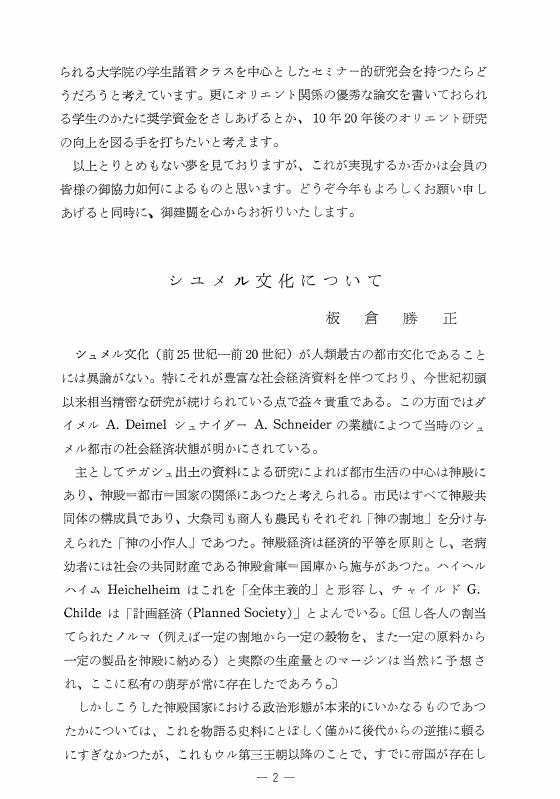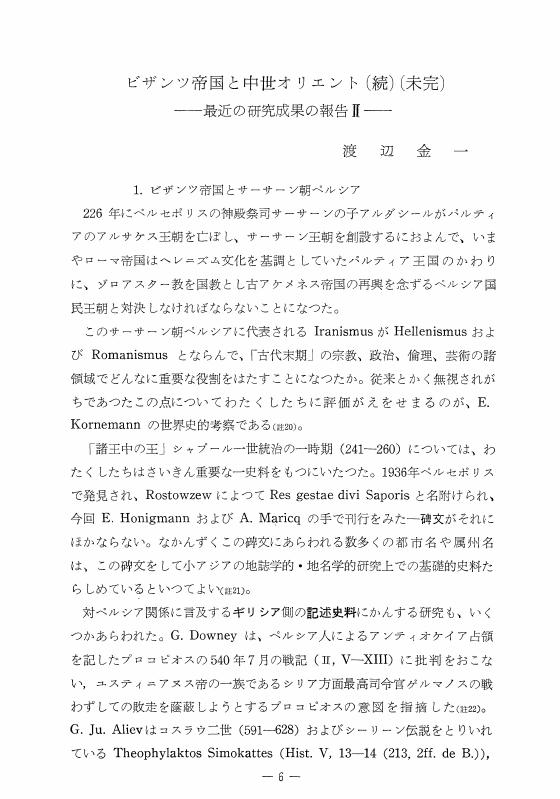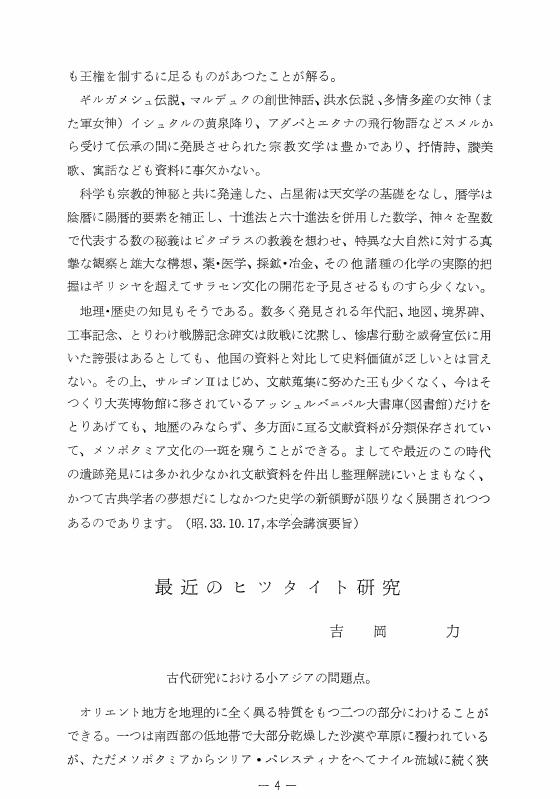1 0 0 0 OA シユメル文化について
- 著者
- 板倉 勝正
- 出版者
- 一般社団法人 日本オリエント学会
- 雑誌
- 日本オリエント学会月報 (ISSN:18841384)
- 巻号頁・発行日
- vol.2, no.1, pp.2-5, 1959-01-25 (Released:2010-03-12)
1 0 0 0 OA ビザンツ帝国と中世オリエント (続) (未完) -最近の研究成果の報告II-
- 著者
- 渡辺 金一
- 出版者
- 一般社団法人 日本オリエント学会
- 雑誌
- 日本オリエント学会月報 (ISSN:18841384)
- 巻号頁・発行日
- vol.2, no.1, pp.6-14, 1959-01-25 (Released:2010-03-12)
1 0 0 0 OA アッシリァ・バビロニア文化の遺影
- 著者
- 定金 右源二
- 出版者
- 一般社団法人 日本オリエント学会
- 雑誌
- 日本オリエント学会月報 (ISSN:18841384)
- 巻号頁・発行日
- vol.2, no.2, pp.1-4, 1959-02-25 (Released:2010-03-12)
1 0 0 0 OA 最近のヒツタイト研究
- 著者
- 吉岡 力
- 出版者
- 一般社団法人 日本オリエント学会
- 雑誌
- 日本オリエント学会月報 (ISSN:18841384)
- 巻号頁・発行日
- vol.2, no.2, pp.4-10, 1959-02-25 (Released:2010-03-12)
- 参考文献数
- 6
1 0 0 0 OA 宋と大食
- 著者
- 桑田 六郎
- 出版者
- 一般社団法人 日本オリエント学会
- 雑誌
- 日本オリエント学会月報 (ISSN:18841384)
- 巻号頁・発行日
- vol.1, no.7, pp.79-83, 1957-03-30 (Released:2010-03-12)
1 0 0 0 OA 奴隷制度の危機と封建制度の起源の問題
- 著者
- ストルーヴエ ヴェ・ヴェ 保田 孝一
- 出版者
- 一般社団法人 日本オリエント学会
- 雑誌
- 日本オリエント学会月報 (ISSN:18841384)
- 巻号頁・発行日
- vol.1, no.8, pp.90-96, 1957-06-30 (Released:2010-03-12)
1 0 0 0 OA ヴェ・ヴェ・ストルーヴェについて
- 著者
- 香山 陽坪
- 出版者
- 一般社団法人 日本オリエント学会
- 雑誌
- 日本オリエント学会月報 (ISSN:18841384)
- 巻号頁・発行日
- vol.1, no.8, pp.96-97, 1957-06-30 (Released:2010-03-12)
1 0 0 0 OA アラビヤ語に於ける「神」の堕落
- 著者
- 田中 四郎
- 出版者
- 一般社団法人 日本オリエント学会
- 雑誌
- 日本オリエント学会月報 (ISSN:18841384)
- 巻号頁・発行日
- vol.1, no.10, pp.112-118, 1958-05-25 (Released:2010-03-12)
The Supreme Being that Islamites worship is called ‘allah’ in Arabic. They believe that Allah is the highest and absolute authority governing the whole universe, and their guiding principle of life is to lead their lives praising and relying upon Him. Their life is strictly regulated by the Koran in many ways because they believe in the Book as the complete record of His words.But on such occasions of their daily life as are less religious, they use the word ‘allah’ in an extremely careless manner. An observation of how the word is used, that is, the place, time, frequency as well as the speaker's feeling and mental attitude, will unmistakably lead to the conclusion that they often use this word in very degenerate senses, as customary or rhetorical uses, and more positively as a means of rationalizing their negligence or evading their responsibilities.In this paper, such degenerate uses of the word ‘allah’ are illustrated with actual examples to prove that on the surface or in their literal senses these expressions seem to show the Islamites' profound sense of awe toward Allah, but in reality the very reverse is the case. The author also ventures his personal opinion on the causes of the growth of such usage.
1 0 0 0 OA ギリシア思想とオリエント
- 著者
- 井上 一
- 出版者
- 一般社団法人 日本オリエント学会
- 雑誌
- 日本オリエント学会月報 (ISSN:18841384)
- 巻号頁・発行日
- vol.1, no.2, pp.10-12, 1955-04-09 (Released:2010-03-12)
1 0 0 0 OA ペルセポリスの遺蹟とその現状
- 著者
- 深井 晋司
- 出版者
- 一般社団法人 日本オリエント学会
- 雑誌
- 日本オリエント学会月報 (ISSN:18841384)
- 巻号頁・発行日
- vol.1, no.2, pp.13-16, 1955-04-09 (Released:2010-03-12)
1 0 0 0 OA 社会学者としてみた最近のイスラエルの印象
- 著者
- モリス ギンスバーク
- 出版者
- 一般社団法人 日本オリエント学会
- 雑誌
- 日本オリエント学会月報 (ISSN:18841384)
- 巻号頁・発行日
- vol.1, no.3, pp.19-25, 1955-09-15 (Released:2010-03-12)
1 0 0 0 OA 古代の近東
- 著者
- ヘンリ フランクフォート
- 出版者
- 一般社団法人 日本オリエント学会
- 雑誌
- 日本オリエント学会月報 (ISSN:18841384)
- 巻号頁・発行日
- vol.1, no.4, pp.28-40, 1956-06-15 (Released:2010-03-12)
1 0 0 0 OA イスラーム
- 著者
- バーナード ルイス 黒柳 恒男
- 出版者
- 一般社団法人 日本オリエント学会
- 雑誌
- 日本オリエント学会月報 (ISSN:18841384)
- 巻号頁・発行日
- vol.1, no.5, pp.45-55, 1956-09-10 (Released:2010-03-12)
1 0 0 0 OA イヂュマーについて
- 著者
- 遠峰 四郎
- 出版者
- 一般社団法人 日本オリエント学会
- 雑誌
- 日本オリエント学会月報 (ISSN:18841384)
- 巻号頁・発行日
- vol.1, no.5, pp.55-57, 1956-09-10 (Released:2010-03-12)
1 0 0 0 OA ウガリト語動詞用法の一問題 三人称男性複数未完了形をめぐって
- 著者
- 小野寺 幸也
- 出版者
- 一般社団法人 日本オリエント学会
- 雑誌
- オリエント (ISSN:00305219)
- 巻号頁・発行日
- vol.19, no.2, pp.17-39,199, 1976 (Released:2010-03-12)
It was as early as 1938 when A. Goetze pointed out the existence of tagtulu (na) verbal form in Ugaritic third masculine plural imperfect conjugation. But virtually all the scholars have done away with this phenomenon as “peculiarity” (e. g. C. H. Gordon), and have not dared to go any further.If we read, however, the text of the Keret Epic carefully, it becomes clear that yagtulu (na) form, which has been universally regarded as the usual verbal form in 3m. pl. impf., does not occur at all. All the thirteen cases in 3m. pl. take the form of tagtulu (na). This finding by the present writer prompted him to investigate all the other Ugaritic material from this viewpoint. The result has been rather drastic. The y-preformative form in 3m. pl. does not appear in the Aqhat Epic either. All the eight examples are in the tagtulu (na) form. Only in the Baal and Anath Cycle and in other minor texts shows up the y-form a few times.In order to explain this interesting phenomenon, one would have to take into consideration the fact that in Amarna Canaanite t-form is employed more frequently than y-preformative conjugation in 3m. pl., a fact first detected by Wm. Moran in 1951. At the same time, one should also pay attention to the situation of Classical Hebrew, where some examples of t-form appear, although to far smaller extent than in Ugaritic and Amarna Canaanite.Based on the results derived from the considerations summarized above, the writer would like to propose some hypotheses as to the possibility of using tagtulu (na) form in 3m. pl. (1) as a chronological criterion to date groups of Ugaritic literature, and (2) as a clue to tighten the link which connects Canaanite dialects or as a clue to subdivide the Northwest Semitic languages in general.
1 0 0 0 OA 岡島誠太郎に連なるエジプト学の系譜
- 著者
- 坂本 翼 銭廣 健人
- 出版者
- 一般社団法人 日本オリエント学会
- 雑誌
- オリエント (ISSN:00305219)
- 巻号頁・発行日
- vol.61, no.2, pp.163-173, 2019-03-31 (Released:2022-04-01)
- 参考文献数
- 73
This paper aims to reconstruct the history of Japanese Egyptology from its birth in the 19th century to the work of Seitaro Okajima in the 1940s. Where exactly did this discipline originate, and what kind of discipline is it? By exploring these questions, this paper attempts to demonstrate that the birth of Japanese Egyptology owes a great deal to the efforts of Shogoro Tsuboi and Kei’ichiro Kume. Next, it examines how Takashi Sakaguchi, who inspired Seitaro Okajima, and Kosaku Hamada, who received over 1,500 Egyptian artefacts from Flinders Petrie, paved the way for academic Egyptology. Finally, this paper explores how Okajima, who had studied under both Sakaguchi and Hamada, developed the discipline to a fuller extent, and the governing idea of his works is discussed.
1 0 0 0 OA アイとホルエムヘブ ポスト・アマルナ時代史の一局面
- 著者
- 河合 望
- 出版者
- 一般社団法人 日本オリエント学会
- 雑誌
- オリエント (ISSN:00305219)
- 巻号頁・発行日
- vol.51, no.2, pp.27-56, 2009-03-31 (Released:2014-03-30)
Scholars have discussed the individual roles of Ay and Horemheb, who were the most influential persons during Tutankhamun’s reign and its aftermath, as well as the relationship between them for ages. Did they work together cooperatively or did some form of competition or hostility exist between them? This article examines the interaction between Ay and Horemheb and their attitudes towards one another through a review of all the available evidence. The first part focuses on their relationship under Tutankhamun and the second with their interactions following Tutankhamun’s death. I demonstrate that they were the most prominent figures in different social groups, suggesting that Ay was the fatherly advisor of the king at the court, while Horemheb was the actual governor of all the administration in the country as the “Regent” and “Generalissimo” under Tutankhamun. By the end of Tutankhamun’s reign, however, Ay seems to have obtained the title “Vizier” and the epithets “doer of maat” and “the one who unites the hands of the god,” representing that he is now capable of governing the country. Ay was indeed on the verge of becoming the successor of Tutankhamun. Therefore, I do not agree with the recent suggestion that Horemheb was the designate successor of Tutankhamun while he was the regent of Tutankhamun. In the second part, I argue that there was strong antagonism between Ay and Horemheb after Tutankhamun’s death. The evidence indicates that Horemheb sought to discredit Ay as proper successor to the king. As a result, Ay appears to have excluded Horemheb from greater courtly influence by appointing Nakhtmin not only as his “Generalissimo” but also as “King’s son.” This squabbling even continued after Ay’s death as Horemheb, once ascended to the throne, soon endeavored to erase all memory of Ay, his men and even Queen Ankhesenamun in revenge.
- 著者
- 江川 ひかり
- 出版者
- 一般社団法人 日本オリエント学会
- 雑誌
- オリエント (ISSN:00305219)
- 巻号頁・発行日
- vol.41, no.2, pp.245-252, 1998 (Released:2010-03-12)
1 0 0 0 OA 玉ネギ学 (Onionology)
- 著者
- 板倉 勝正
- 出版者
- 一般社団法人 日本オリエント学会
- 雑誌
- オリエント (ISSN:00305219)
- 巻号頁・発行日
- vol.12, no.1-2, pp.128, 1969 (Released:2010-03-12)
1 0 0 0 OA アナスタシオス帝治世下の宗教騒乱と修道士について
- 著者
- 飯島 克彦
- 出版者
- 一般社団法人 日本オリエント学会
- 雑誌
- オリエント (ISSN:00305219)
- 巻号頁・発行日
- vol.54, no.1, pp.59-74, 2011-09-30 (Released:2015-02-27)
- 参考文献数
- 39
In the Early Byzantine period (330-610), religious unrests frequently occurred. Traditionally, it has been said that monks provoked the people to create the unrests. However, T. E. Gregory and F. Winkelrnann have questioned this view. This paper examines the religious unrests in Constantinople in the time of the emperor Anastasius I (491-518), and attempts to correct the image of the monks as the sole catalysts behind them. The following points have been discussed: 1. To what extent did the monks involve themselves in the unrests? 2. How different were the attitudes of the monks and the people toward the patriarch Macedonius II (496-511), during whose term most of the religious unrests occurred? 3. Beside the monks, who could have provoked the people to riot? The conclusions are as follows: 1. Of the religious unrests that took place in 496, 508, 511 and 512, the monks were involved in two (511 and 512), but they either triggered these unrests or formed a coalition with the people rather than playing a main role. Some monks who opposed the unrests were even killed by the people in the riot of 512. 2. Although Macedonius was hesitant to hold a firm doctrinal position, the Chalcedonian people constantly supported him, while the monks did not. 3. In addition to the monks, the patriarch and the priests could have also provoked the people to riot.














